Saturday, 25 May 2013: Avignon to Nîmes via the Pont du Gard; sad news
Written Tuesday, 11 June 2013
Our plan for Saturday morning was to leave Avignon about 10 a.m. to drive to Nîmes, with a stop on the way to visit the famous Pont du Gard. Unfortunately, Jeff came to us at 9:30 a.m. with the sad news, just received by e-mail, that his mother had died in the night. He and CJ needed to go home. The event was not altogether unexpected. She had been in stable condition for eight weeks before the trip, but we knew before any of us went that Jeff and CJ's stay might have to be cut short.
We therefore waited while Jeff called his father and then worked with the airline to change their travel arrangements. The earliest flight they could get was at 1:30 p.m. Sunday, so once that was settled, we set out a little late but otherwise as planned for the Pont du Gard.
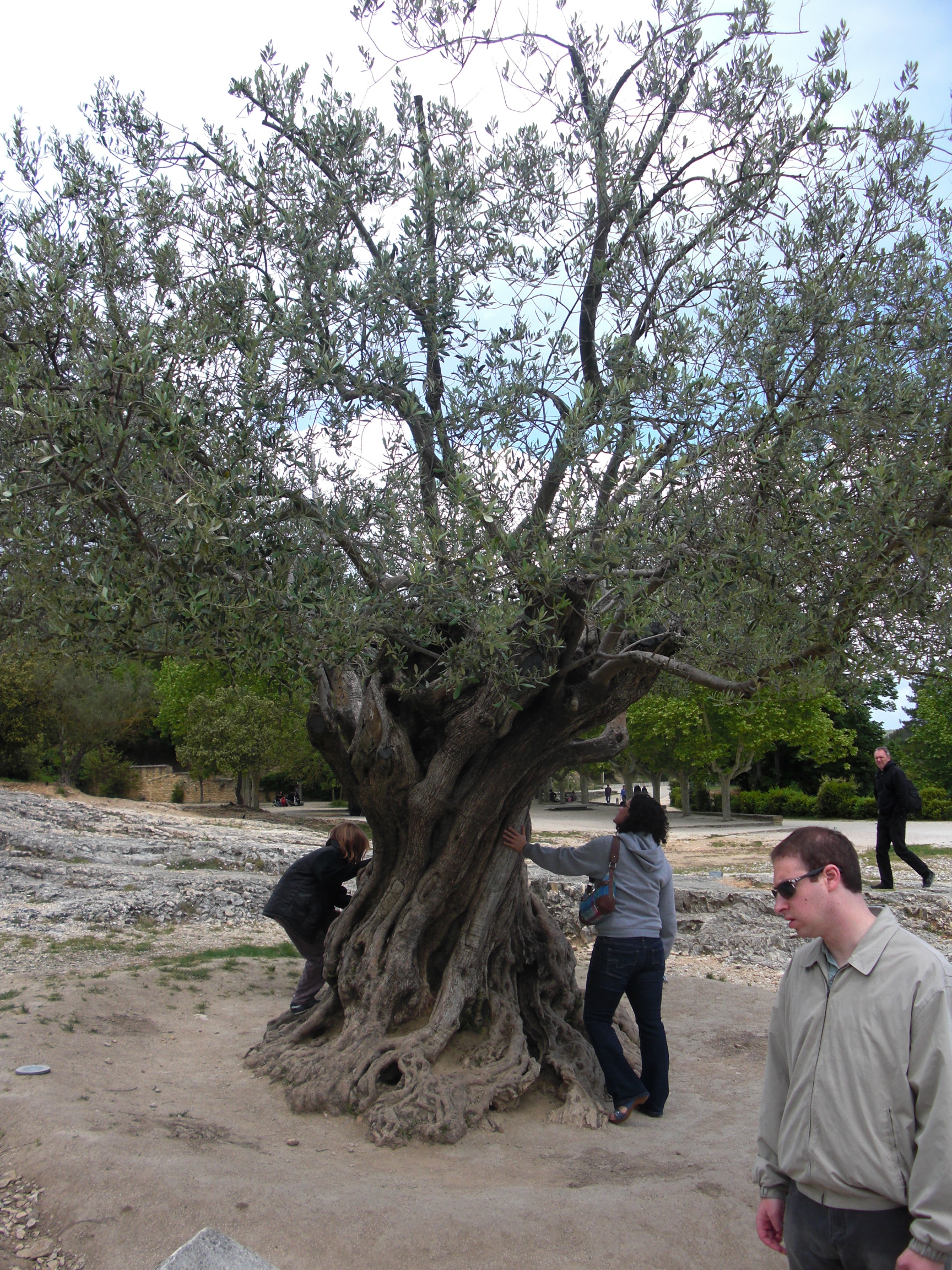
 The trip wasn't long, so we still arrived before lunch time. At the entrance to the grounds, we paid the entry fee of 18 euros, good for a car with up to five passengers, which covered parking, admission to the museum, and access to the bridge itself. It's called a bridge, and it does in fact, since the 18th century, include a bridge, which one can walk across, but originally, the Pont du Gard was just the largest elevated section of the amazing 31-mile aquaduct the Romans built to bring water from a spring in Uzès to Nîmes. Along the way, the aquaduct supplied (legally) a number of smaller settlements and (illegally) any number of small farmers and landholders who cut themselves little holes in the duct to draw off water for their own use.
The trip wasn't long, so we still arrived before lunch time. At the entrance to the grounds, we paid the entry fee of 18 euros, good for a car with up to five passengers, which covered parking, admission to the museum, and access to the bridge itself. It's called a bridge, and it does in fact, since the 18th century, include a bridge, which one can walk across, but originally, the Pont du Gard was just the largest elevated section of the amazing 31-mile aquaduct the Romans built to bring water from a spring in Uzès to Nîmes. Along the way, the aquaduct supplied (legally) a number of smaller settlements and (illegally) any number of small farmers and landholders who cut themselves little holes in the duct to draw off water for their own use.
Our parking lot was on the left bank, where the museum was located but where the food options were rather prepackaged and bleak. We therefore set off to walk across the bridge to the right bank, where prospects were supposed to be better.
On the left here is an olive tree we encountered on the 300-meter walk to the bridge. A stone plaque nearby (which Jeff is reading while CJ examines the tree itself) reveals that it was planted in the year 908, but not here. It and two others were growing in a cold, arid valley in Spain when the Council General of the Gard (the département in which the Pont du Gard is located) acquired them and moved them to this site in 1988.
On the right is another of the three, but no plaque indicates its exact age.
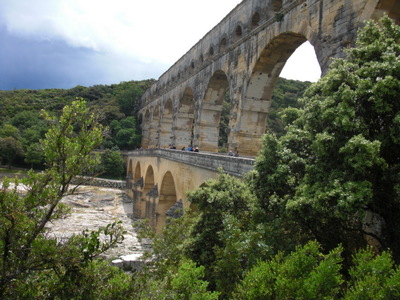
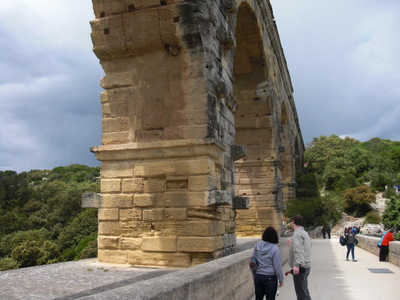 On the left is the view of the structure from the left bank, and on the right our view as we walked over it.
On the left is the view of the structure from the left bank, and on the right our view as we walked over it.
The Roman engineers really knew what they were doing. The spring is only about 12 miles from the city, and only 17 feet higher, but the aquaduct takes a very winding route to avoid some hills the Romans couldn't tunnel through. The down-hill gradient is only about 1 in 3000 (i.e., the downhill end of the channel in the Pont du Gard is less than an inch lower than the uphill end), but that was sufficient to keep about 2 million liters of water a day flowing through it. It was built in the 1st century A.D. and served well for a good long time, but maintenance got spotty after the 4th century, and it started to deteriorate. The spring water was very hard, so calcareous scale kept building up and narrowing the channel, and vegetation was always worming its way in.
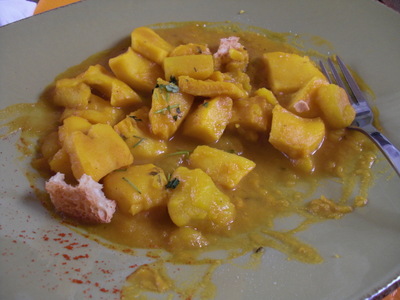
 The menu on the right bank was in fact better, but the restaurant was jammed (several tour buses were parked on that side of the river, so the only room for us was outdoors despite the chilly drizzle) and the service was dreadful. We finally had to leap up and grab a waiter as he zoomed by, just to get spoons to eat our soup.
The menu on the right bank was in fact better, but the restaurant was jammed (several tour buses were parked on that side of the river, so the only room for us was outdoors despite the chilly drizzle) and the service was dreadful. We finally had to leap up and grab a waiter as he zoomed by, just to get spoons to eat our soup.
CJ had fisherman's soup (the usual brown soup with croutons, rouille, and cheese), and I had rouille du pêcheur (left) a sort of stew of potatoes and thick chunks of cuttlefish. The menu said it came with croutons and rouille, and the waiter finally brought croutons when I insisted, but he swore the rouille was already in it, although it was pretty miserably bland. CJ didn't want her rouille, so she gave it me me, and that improved it immeasurably.
David had another goat-cheese salad. The feuilles de brik were still pasty pale, as though they were raw, but they had at least gotten crisp.
I'm afraid I don't remember what Jeff ordered, but because I didn't take a photo, it was probably the same thing as someone else.

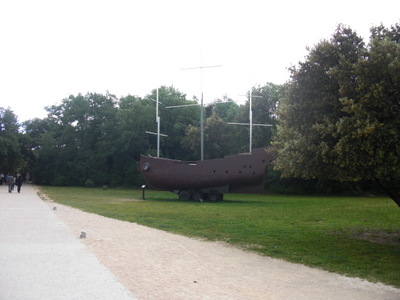 Here's the view of the bridge/aquaduct from the right bank; as you can see, the sun had finally come out again.
Here's the view of the bridge/aquaduct from the right bank; as you can see, the sun had finally come out again.
Back on the left bank, on our way to the museum, we passed this odd ship-shaped work of art labeled the "Holey Glory."
The museum didn't allow photography—too bad, because it had some wonderful exhibits. Large parts of the Nîmes aquaduct were underground, but anywhere it had to cross a low spot, the Romans built an aquaduct, a couple of dozen of them in the 31 miles. The museum had a set of scale models of them all, from little ones 20 feet long with one arch up to the Pont du Gard, the highest one they ever built. It had great maps of the aquaduct system and photos of the channel at various points along it, including some stretches with really impressive calcium buildups and gnarled root balls. Panels explained how successful the program of bringing water to Nîmes was, allowing the baths to be especially lavish and many fountains to be built. We saw full-size models of the pulley and crane systems used to lift the stone blocks into place and diagrams of the holding and routing basins placed at strategic points in the system. They even showed a film of the route of the aquaduct shot from the air, tracing its route the whole way. Impressive.
On the way to Nîmes, we stopped to buy gas again, because we couldn't be sure of being able to buy it on Sunday, and we really didn't want to run low on the way to and from the airport. We found a supermarket with manned pumps but then had to wait a surprisingly long time. The arrangement provided at least eight pumps, but to pay, each driver had to pull up to a little kiosk, like a toll booth, which caused a bottleneck because the cashier couldn't handle the transactions anywhere near as fast as people could fill up. Because each pump couldn't be zeroed until the last person to use it reached the head of the payment queue, the process couldn't progress any faster than if they'd had only a couple of pumps. We put in another 30 euros' worth, and that was all the gas we bought during the whole three-week trip. The tank was full when we picked up the car, and we returned it about 1/4 full (because Europcar's gas price was better than you could get on the street), and we in put a total of 45 euros' worth—very good mileage indeed.
In Nîmes, I was surprised to find that my Google area map was wrong; it reversed the directions of a crucial pair of one-way streets!—but the GPS got us there. We parked in the train station's underground garage, which happened to be right next to our hotel, but when I asked about parking at the hotel, I was told that, no, the 8-euro-per-night parking we had reserved was just as nearby but in the Ibis's private garage, about 100 yards from where we had initially parked, and that the train-station garage would be much more expensive.
So Jeff and CJ set off to explore Nîmes on foot—it would be their only chance—while David and I moved the car; we agreed to meet them at the evening's restaurant, which I marked on their city map.
Picture an equilateral triangle with one point toward you. The train station forms the side farthest from you, and our hotel, together with a couple of other building, one of which contained the hotel's garage, are inside the triangle. Coming into town, we had arrived at the point nearest you, borne right (onto one of the one-ways that Google got wrong), turned left just before the train station, where the road plunged into a short tunnel, and (at the low point of the tunnel) turned right into the parking garage. Now we needed to come back out of the station's garage continue through the rest of the tunnel, turn left on the other one-way leg of the triangle, turn left again on our original one-way leg, and turn left into the hotel's garage. Unfortunately, the clerk who gave me these directions neglected to mention that the garage had two exits, and we guessed wrong. After bushwhacking our way through a long loop to the right, we managed to get back to the triangle, turned onto the correct leg of it, and turned left into what turned out to be the wrong garage. Fortunately, an attendant there immediately realized we must be in the wrong place and let us out to try again. This time, we got around the triangle correctly, passed the wrong garage, and found the right one, very discretely labeled with the hotel's name. Yeesh!
Unfortunately, careless driving directions were not the hotel's only defect. No lobby telephone was available, so I had a lot of trouble contacting restaurants to change our future dinner reservations, which were all for four people. My room had no toilet paper. This hotel didn't supply bathmats. The whole place had a much less welcoming feel than the great Ibis Budget in Avignon. We couldn't cancel the second and third nights of Jeff and CJ's room (or their night at the Ibis Budget at the airport) because they were nonrefundable. They did at least give us the parking free.
The evening's restaurant, Vincent Croizard, was on a very unpromising-looking street—dark and out of the way. We could look down the length of it from one end and saw no sign of any commercial establishment. But when I looked at the nearest building to find a house number, I saw that the restaurant should be just two doors away, and so it was—a plain wooden door in a plain stone wall with only a small brass plaque beside it to indicate its identity. We rang the bell and were admitted to what, inside, looked like a conventional restaurant. Jeff and CJ showed up about 10 minutes later, having been tempted by the sight of distant fountains to walk farther than they had intended.

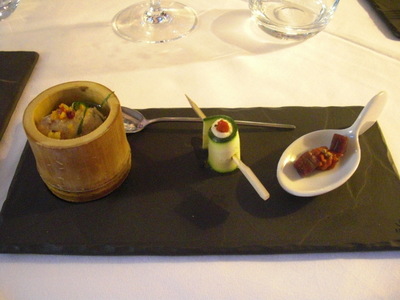 The menu was entirely à la carte, so we all ordered separately.
The menu was entirely à la carte, so we all ordered separately.
The first amuse-bouche was seasoned fromage blanc with breadsticks. (Breadsticks seem very popular this year, or maybe it's just in this region; we encountered them frequently, though not usually in the higher-end restaurants.)
The second was threefold: a bamboo cup of warm puréed lentil soup with brandade de morue and a spinkle of lemon peel on top, fresh goat cheese wrapped in a thin slice of zucchini, and a dab of tomato confit flanked by cubes of duck magret.
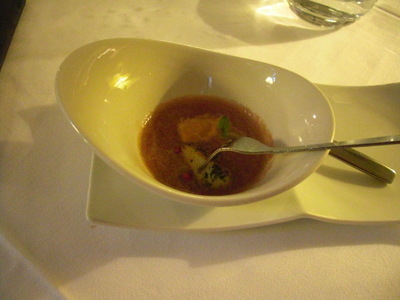
 The third amuse-bouche was a small soup of grilled cuttlefish.
The third amuse-bouche was a small soup of grilled cuttlefish.
First course, me: Lamb sweetbreads braised with fennel seeds, accompanied by confit tomatoes, cream of smoked garlic, and "lentin" mushrooms. Excellent. The sweetbreads had wonderful texture. According to Wikipedia, a whole group of mushrooms from the genera Lentinus, Lentinellus, and Lentinula are called "lentin"; I don't know which these were, but they were similar in taste and texture to shiitakes, which are Lentinula edodes.
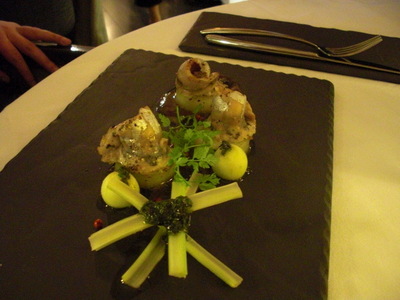
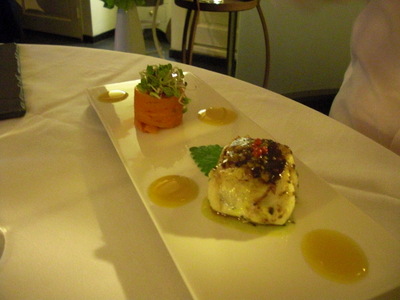 First course, Jeff: "Gascon," a fish in the genus Trachurus, members of which are called "scad" or "horse mackerel" in English. It was marinated, then rolled into turbans and roasted with bay leaves and fenugreek. Served with celery (or maybe fennel) sticks, slices of Granny Smith apple, and potato balls.
First course, Jeff: "Gascon," a fish in the genus Trachurus, members of which are called "scad" or "horse mackerel" in English. It was marinated, then rolled into turbans and roasted with bay leaves and fenugreek. Served with celery (or maybe fennel) sticks, slices of Granny Smith apple, and potato balls.
First course, David: Cod, lightly smoked and dressed with citrus oil, soy, anise, and smoked salt. Neat timbale of carrots on the side.

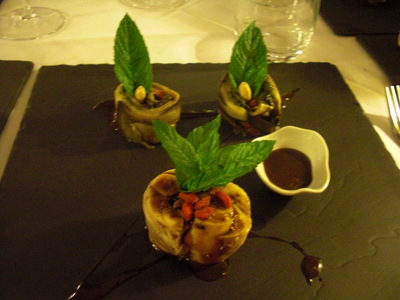 First course, CJ: A deconstructed organic egg. The yolk was poached and served on a round of herb toast, and the white was cooked as a tall cylinder and topped with herb oil. On the side, a sauce of roasted red bell pepper and a little cylinder of raw ham with Espelette pepper dust.
First course, CJ: A deconstructed organic egg. The yolk was poached and served on a round of herb toast, and the white was cooked as a tall cylinder and topped with herb oil. On the side, a sauce of roasted red bell pepper and a little cylinder of raw ham with Espelette pepper dust.
Main course, everybody: Rabbit. The meat was rolled around the liver and roasted with black olives and mint leaves. Delicious. Sauce of the reduced stock from the rabbit bones. On the side, eggplant rolled around red bell pepper. Each portion except CJ's had a single blanched almond stuck into each eggplant roll. On top, a few goji berries, which the hostess tried to tell us were the dried anthers of a lily. I didn't believe that for a minute, so I looked them up—they're the berries of Lycium chinense and L. barbarum, in the Solanaceae, i.e. tiny tomato relatives.

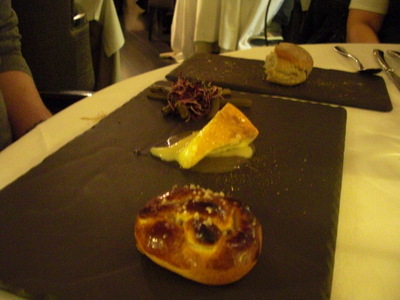 Rather than a cheese trolley, the restaurant offered two set cheese courses.
Rather than a cheese trolley, the restaurant offered two set cheese courses.
Cheese, CJ, David, and me: Brillat Savarin, a mild creamy cheese, stuffed with morels, with a Madeira glaze, sage oil, and nutmeg. Yummy, but not necessarily an improvement on the plain cheese served with a little bread.
Cheese, Jeff: Münster (the Alsatian kind, not the bland waxy stuff at Publix) with honey and cumin, a reduction of amber beer, pickled green beans, and a bretzel (sort of like a pretzel, but more bread-like, another Alsatian specialty).
After the cheese, we were served a palate cleanser: a little cup of cold tea of lemon verbena and mint.
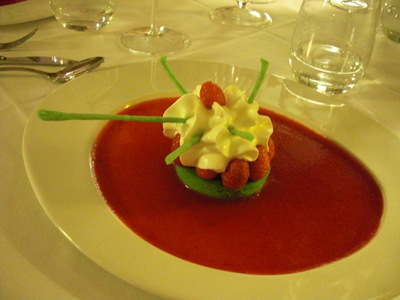
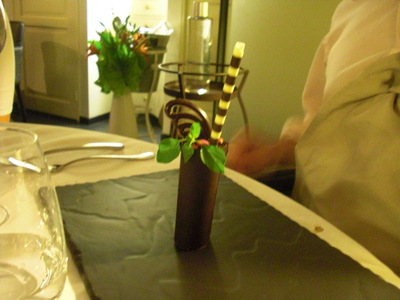
Dessert, Jeff, CJ, and me: Strawberries and green peas, with cream (from Isigny in Normandy) flavored with orange flower water. Yes, green peas. They were baked into a sort of soft, not very sweet cake on top of which were piled Garriguette strawberries, then cream, all surrounded by a coulis of strawberries. The little meringue rods stuck into the cream like antennae must also have been flavored with green peas. Perfectly okay, but no particular synergism with the strawberries.
Dessert, David: "Chocolate 67." I assume that means 67% cocoa. Anyway, a tall chocolate tube with chocolate-, rum-, and tonka-flavored fillings, described on the menu as a "play on textures." In the background, above David's dessert, you can see the tall cylindrical "Cryo" bottle of filtered water. That's such a good idea! I'm going to start requesting Cryo water everywhere we dine, hoping to increase the impression of demand for it.
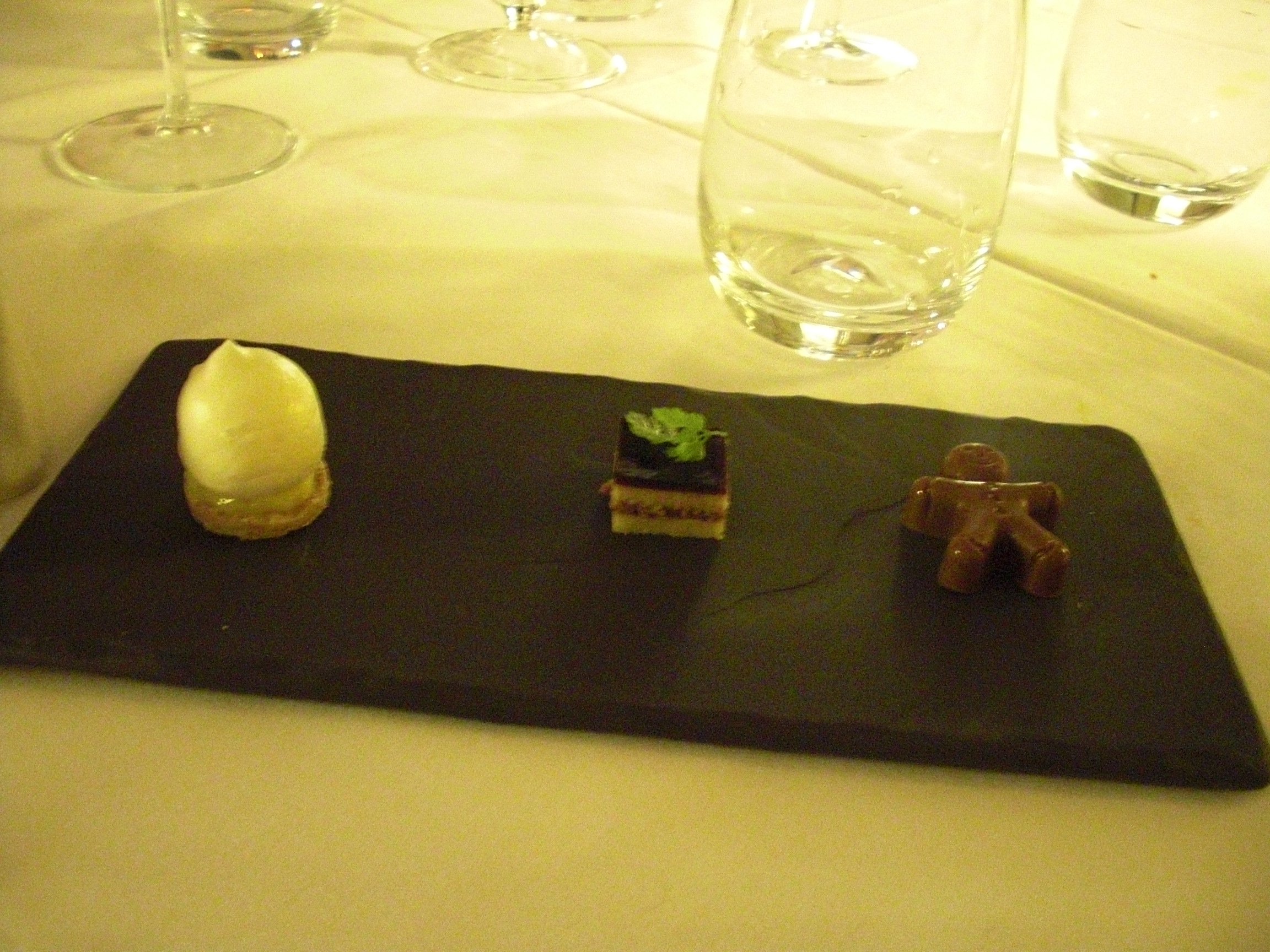 Mignardises: For each of us, a tiny lemon meringue tart (the meringue was crisp), a chocolate-black-olive petit four, and a little chocolate man flavored with speculoos cookies and cumin. He melted in the mouth but also in the hand.
Mignardises: For each of us, a tiny lemon meringue tart (the meringue was crisp), a chocolate-black-olive petit four, and a little chocolate man flavored with speculoos cookies and cumin. He melted in the mouth but also in the hand.
previous entry
List of Entries
next entry

 The trip wasn't long, so we still arrived before lunch time. At the entrance to the grounds, we paid the entry fee of 18 euros, good for a car with up to five passengers, which covered parking, admission to the museum, and access to the bridge itself. It's called a bridge, and it does in fact, since the 18th century, include a bridge, which one can walk across, but originally, the Pont du Gard was just the largest elevated section of the amazing 31-mile aquaduct the Romans built to bring water from a spring in Uzès to Nîmes. Along the way, the aquaduct supplied (legally) a number of smaller settlements and (illegally) any number of small farmers and landholders who cut themselves little holes in the duct to draw off water for their own use.
The trip wasn't long, so we still arrived before lunch time. At the entrance to the grounds, we paid the entry fee of 18 euros, good for a car with up to five passengers, which covered parking, admission to the museum, and access to the bridge itself. It's called a bridge, and it does in fact, since the 18th century, include a bridge, which one can walk across, but originally, the Pont du Gard was just the largest elevated section of the amazing 31-mile aquaduct the Romans built to bring water from a spring in Uzès to Nîmes. Along the way, the aquaduct supplied (legally) a number of smaller settlements and (illegally) any number of small farmers and landholders who cut themselves little holes in the duct to draw off water for their own use.
 On the left is the view of the structure from the left bank, and on the right our view as we walked over it.
On the left is the view of the structure from the left bank, and on the right our view as we walked over it.
 The menu on the right bank was in fact better, but the restaurant was jammed (several tour buses were parked on that side of the river, so the only room for us was outdoors despite the chilly drizzle) and the service was dreadful. We finally had to leap up and grab a waiter as he zoomed by, just to get spoons to eat our soup.
The menu on the right bank was in fact better, but the restaurant was jammed (several tour buses were parked on that side of the river, so the only room for us was outdoors despite the chilly drizzle) and the service was dreadful. We finally had to leap up and grab a waiter as he zoomed by, just to get spoons to eat our soup.
 Here's the view of the bridge/aquaduct from the right bank; as you can see, the sun had finally come out again.
Here's the view of the bridge/aquaduct from the right bank; as you can see, the sun had finally come out again.
 The menu was entirely à la carte, so we all ordered separately.
The menu was entirely à la carte, so we all ordered separately.
 The third amuse-bouche was a small soup of grilled cuttlefish.
The third amuse-bouche was a small soup of grilled cuttlefish.
 First course, Jeff: "Gascon," a fish in the genus Trachurus, members of which are called "scad" or "horse mackerel" in English. It was marinated, then rolled into turbans and roasted with bay leaves and fenugreek. Served with celery (or maybe fennel) sticks, slices of Granny Smith apple, and potato balls.
First course, Jeff: "Gascon," a fish in the genus Trachurus, members of which are called "scad" or "horse mackerel" in English. It was marinated, then rolled into turbans and roasted with bay leaves and fenugreek. Served with celery (or maybe fennel) sticks, slices of Granny Smith apple, and potato balls.
 First course, CJ: A deconstructed organic egg. The yolk was poached and served on a round of herb toast, and the white was cooked as a tall cylinder and topped with herb oil. On the side, a sauce of roasted red bell pepper and a little cylinder of raw ham with Espelette pepper dust.
First course, CJ: A deconstructed organic egg. The yolk was poached and served on a round of herb toast, and the white was cooked as a tall cylinder and topped with herb oil. On the side, a sauce of roasted red bell pepper and a little cylinder of raw ham with Espelette pepper dust.

 Rather than a cheese trolley, the restaurant offered two set cheese courses.
Rather than a cheese trolley, the restaurant offered two set cheese courses.

 Mignardises: For each of us, a tiny lemon meringue tart (the meringue was crisp), a chocolate-black-olive petit four, and a little chocolate man flavored with speculoos cookies and cumin. He melted in the mouth but also in the hand.
Mignardises: For each of us, a tiny lemon meringue tart (the meringue was crisp), a chocolate-black-olive petit four, and a little chocolate man flavored with speculoos cookies and cumin. He melted in the mouth but also in the hand.